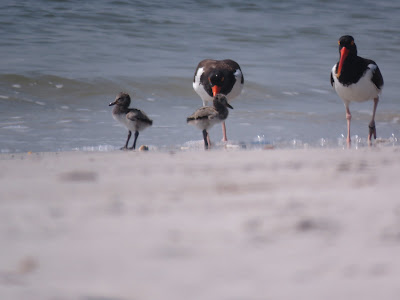Lindsay Addison, our NC Audubon Biologist, counted 259 Least Tern nests in the colony on Tuesday, 5/11. And we have chicks! The chicks blend into their surroundings and spend a lot of time safely under a parent. But with some luck and patience you will see them. And soon they will be running all over the beach.
There is lots of activity underway on the south end…including courtship, mating, nesting and incubating eggs!
It is a challenge counting the Black Skimmers and Common Terns because of all of the vegetation but when the colony “flushes” we can easily see over 500 birds!
Some of you may be wondering what causes the birds to all fly up. First look for the obvious .... a person that is too close to the posting or a Gull or Crow(s). Then look on the ground for a potential disturbance. We have seen a Ruddy Turnstone walking around the colony and Ruddy Turnstones are known to predate eggs. Tuesday morning some Wrightsville Beach Bird Stewards saw a beautiful Corn Snake at Beach Access 43 going into the dunes. Often, especially in the early part of the breeding season, for no known reason, most or all of the terns will fly in silence low and fast over the colony or out to the water. This phenomenon is called a "dread flight".
Least Terns
Look closely at the Least Tern nests for evidence of hatching which is just beginning. Parents sitting on nests will have their wings lightly extended to shade chicks as they hatch.
Black Skimmers
Black Skimmers continue with fish presentations, scrape making and mating. Nesting and incubating will begin shortly.
Gull-Billed Terns
The Gull-Billed Terns have a unique courtship behavior and several of us were able to witness what appears to be a little dance. The couple lightly extend their wings and walk in a circle around each other before mating.
Other birds…Spring Migration is still underway and you may see other birds on the beach. Look for other shorebirds including Red Knots and Semi-palmated Sandpipers who are in the area now. A group of Short-billed Dowitchers made an appearance today. And a large group of Royal Terns gathered on the east side of the colony for awhile.
 |
| Short-billed Dowitchers |
Royal Terns made a brief stop in the middle of the Least Tern nesting area and were quickly made to feel unwelcomed!
Activity in the colony is just starting to get busy!






















































